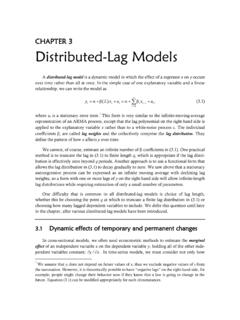Transcription of 2022 Deloitte travel outlook The winding path to recovery
1 2022 travel outlook | 1 2022 Deloitte travel outlook The winding path to recovery2022 travel outlook | 2 The COVID-19 pandemic disrupted several industries, but travel fell particularly hard and fast. US air passenger volume plummeted by more than 90% in March 20201, and in April 2020 hotel occupancy dove to 25%.2 travel showed its resilience when relief arrived in the form of vaccines. Pent-up demand surfaced quickly; Americans intent to make bookings doubled across most travel categories from February to September , travel will likely be one of the last consumer sectors to see demand return at full strength. Pandemic concerns continue to curtail some plans, especially for international and corporate trips. And when concerning variants arise, so does talk of new cross-border restrictions.
2 But for the travel industry, 2022 is about more than simply watching air passenger volumes increase and hotels occupancy rates pick up as visitors return to cities and beaches. Some trip types will fare better than others, and some demographic groups will lag others. The pandemic has brought changes to the way we live and work. Some of those changes are likely to continue to affect travel once the health crisis subsides. Deloitte has been tracking consumer sentiment, including travel purchase intent, since April 2020 via our Global State of the Consumer Tracker. In 2021, Deloitte published three reports delving deeper into travel demand, including one on the future of corporate travel . Read on to discover the six major developments we are watching in the year travel moves toward recovery , new forces will shape its futureFigure 1.
3 Why we fly matrix: Corporate travel use cases by business impact and tech replaceabilitySource: Deloitte 2021 Holiday travel Survey, N=150 and interviews with executives with oversight of business travel spend and meetings & presentationsInternal team meetingsInternal training, learning and developmentIndustry conferences for contentExhibitions & tradeshowsIndustry conferences to networkClient project workClient relationship buildingSales or Client acquisitionOn-site visits & monitoringLess essential to businessMore essential to businessReplaceable by technologyDependent on in-person interaction2022 travel outlook | 3 Corporate travel demand should improve significantly when workers return to offices in greater numbers, enabling more client visits. That development appears likely during the first half of 2022.
4 However, omicron or another variant could lead companies to slow their returns to the office, as happened with the delta variant in the assuming the best possible COVID-19 outcomes, corporate travel in 2022 is unlikely to reach or even near 2019 levels. Not all road warriors will be eager to return to their pre-pandemic frequency. Not all clients will immediately welcome the same volume of visitors they did in 2019. At the same time, CEOs and CFOs will likely continue to closely scrutinize travel spend and return on investment after operating successfully with so few trips. Less travel also means less emissions. Half of companies say they are optimizing their business travel policies to support sustainability For most, this translates to measures like curtailing trip frequency, optimizing agendas to mitigate flying, limiting long-haul, and transitioning more meetings s leisurely returnVideo call fatigue may have set in and a preference for more in-person interaction may be on the rise.
5 But companies have learned a lot over the last two years about which meetings require getting on a flight, and when conferencing software can suffice. Respondents to Deloitte s corporate travel survey say travel that helps establish and foster client relationships is the most essential to success and least replaceable by technology. Trips to visit prospects and network at conferences will likely come back strongest (see Figure 1), while internal training and meetings will continue to rely heavily on virtual connection. The health concerns of COVID-19 could continue to hamper business travel for much of 2022. As direct pandemic effects eventually fade, the more durable forces of the bottom line and sustainability priorities are likely here to stay, supported by virtual conferencing and collaboration.
6 As executives navigate corporate travel s return, opportunities exist for travel providers to partner, advise, and provide new tools to address reassessed priorities. StruggleBattlegroundNicheThrive2022 travel outlook | 4 While the rise of virtual meetings will likely slow the return of corporate travel , workers newly untethered from the office offer upside. Laptop-lugging leisure travelers are taking more trips, and adding days and dollars to those trips (see Figure 2). The rise of remote work can do more than expand the travel pie. These laptop luggers have above-average buying power, greater flexibility on travel dates, and a unique set of needs according to our research. Remote working elevates a few considerations for these travelers: a quiet and comfortable space, perhaps away from the rest of the travel party fast and reliable Wi-Fi5 convenient access to wellness-related amenities like healthy meals on the go, and fitness equipment and activities the ability to reschedule in-destination activities to accommodate workAs travel suppliers seek to better serve the evolving needs of remote workers, some are already capitalizing on their trend toward more frequent trips.
7 Subscription models, which have historically struggled due to low frequency of travel , are getting a second look. The corporate subscription by CitizenM and Mandarin Oriental Washington s MOBase target travelers for whom the lines between work, travel , and everyday life continue to blur. And as suppliers try to recast loyalty in the face of less corporate travel , higher-spending laptop luggers and their particular demands will likely garner more attention in the year s remote work opportunityTravelers with intent to fit in some work while away planned twice as many trips this holiday seasonWorking vacationers were more than twice as likely to increase the budget for their leisure trip as compared to 2019 Disconnectors1-2 tripsDisconnectors13%Laptop luggers2-4 tripsLaptop luggers29%Figure 2. Untethered from the office, workers with flexibility are expanding the travel pieSource: Deloitte 2021 Holiday travel Survey, N= than half of these laptop luggers added three or more days to the duration of their longest leisure trip due to remote workingTrips extended days19%3-6 days38%1-2 weeks12%2+ weeks6%In summer 2021, 28% of rental travelers stayed at one for the first time during the pandemic.
8 By the holiday season, the number rose to 43% of rental customers choosing a private rental for the first time during the 3. Private rental adoption has surged, and many say they will continue using this lodging typeSource: Deloitte 2021 Holiday travel Survey, N= travel outlook | 5 Remote work could be a long-term accelerator of another major hospitality industry trend: Private rentals move into the mainstream of accommodations. Hotels still account for a majority of leisure lodging spend. In 2021, over both the summer and holiday seasons, more than 80% of travelers staying in paid lodging planned hotel stays. That was about three times the share of those planning to stay in rentals. But COVID-19 is tilting the lodging landscape. By the 2021 holiday season, more than four in 10 rental travelers say they have been introduced to the accommodation type for the first time during the pandemic (see Figure 3).
9 Health concerns were a major driver of rental demand in 2020 and 2021, as more space enabled social distancing. Rental surge to continueBut travelers plan to keep rentals in the mix. Three in four new rental travelers said they expect to continue choosing the accommodation type after the pandemic. And the above-mentioned effects of remote work on travel longer trips and the need for space to work could help buoy rentals popularity as health concerns interest in alternative accommodations will likely continue to push hospitality providers to evolve. Hotels that can will elevate home-like amenities, such as kitchens, adjoining rooms, and space to work. In the rental space, platforms will continue to invest in providing a more consistent, predictable experience and serving trip types including business travel .
10 How often do you stay at private rentals?Three in four new rental guests expect to continue staying in rentals for at least half their trips going forward43%14%21%22%Prepandemic: Regular frequencyFirst stay earlier during the pandemicPrepandemic: Occasional frequencyFirst stay in the 2021 holiday seasonLower-income(Less than $50K)20%Middle-income($50K $100K)22%Higher-income(More than $100K)24%Percent of travelers spending less on travel in 2021 so they can travel overseas when it becomes more convienientOverall, 22% of travelers say they were holding back spending in 2021 to be able to travel internationally once it is more accessible. Figure 4. Saving up for an international trip2022 travel outlook | 6 COVID-19 and the border restrictions it brought about slowed cross-border travel to a trickle.
















